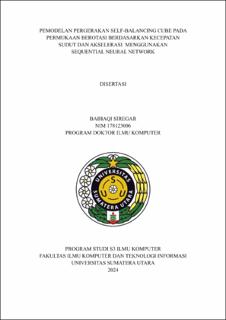Pemodelan Pergerakan Self-Balancing Cube pada Permukaan Berotasi Berdasarkan Kecepatan Sudut dan Akselerasi Menggunakan Sequential Neural Network
Modeling The Movement of a Self-Balancing Cube on Rotating Surface Based on Angular Velocity and Acceleration Using Sequential Neural Networks

Date
2024Author
Siregar, Baihaqi
Advisor(s)
Sitompul, Opim Salim
Budiman, Mohammad Andri
Fahmi
Metadata
Show full item recordAbstract
Self-balancing Cube is a device that is able to maintain its own balance by utilizing a reaction wheel control system. By utilizing the action-reaction principle, the reaction wheel can correct the position of the Self-balancing Cube in real-time with precise orientation control and stabilization. A significant challenge arises when the Self-balancing Cube experiences external disturbances that impact its instability. This research examines the influence of external disturbances in the form of rotating surfaces on the movement of the Self-balancing Cube, by modeling its condition classification based on acceleration and angular velocity data. The conditions that occur are classified as Balance, Turbulence, and Collapse. The Sequential Neural Network model was developed to be able to correctly classify the movement of the Self-balancing Cube. This research also applies five other classification algorithms as performance comparison instruments for the models developed. Mathematical formulas were also produced from this research to measure the best performance based on the model's ability to identify the desired priority conditions, namely Turbulence for predictive maintenance purposes. The calculation results show that one model obtained an overall score of 5.335 which makes it the best model out of the 96 types of investigation scenarios carried out. The best model was produced from analysis of the angular velocity when the Self-balancing Cube moves with a Fast Fourier Transform size of 256.
